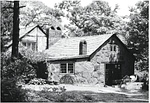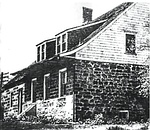Losing Our Historic Houses
Early in 1925, a small group of friends created the beginning of Woods Road in Palisades by clipping a path through the thick woods that had been part of the Peet farm before Mary Tonetti bought the land. They went on to build two charming, idiosyncratic houses on the new road, completed by that fall. They named the houses they built “The Thatched House” and “The House in the Woods.” The group consisted of Bobby Hyde, a free-spirited Californian who had married Lydia Tonetti and moved to Palisades, Lydia, and their friends Dick and Ruth Salmon.
Dick Salmon later chronicled the construction, which was unusual, to say the least. He wrote about the building of the House in the Woods:
“Bob had what seemed to me a new idea in stone construction. He made forms of boards as one would do were he to make a mold for pouring concrete. He then took his small caterpillar tractor, trailing a do-it-yourself stone boat, into the interland woods and, using a crow bar, would pry out any stone with a flat surface. The thickness of the stones didn’t matter, just as long as they weren’t more than a foot. These he piled into the stone boat and, like a war tank, he’d drag the stones back, place the flat side facing the form boards and fill in behind with rubble, bottles, anything, and surround the whole conglomerate with loose, wet concrete. Just before it set solid, he’d remove the outside boards from the form and “point” the wall as a brick-layer does with a trowel; cleaning away extrudences and filling crevices. The result was a fine flat surface of irregular stone work. He left rectangular spaces for windows and doors. He had no blue prints; he built with the finished design in his mind. Somewhere, he got two enormous mill stones, one which he placed in the wall over the highpeaked, living room fireplace.”
Ruth Salmon remembers being given a roll of linoleum and being told to lay it by reading the directions. They built a wine cellar, and later made some wine to go in it. The pool was made to serve as a greenhouse in the winter where they kept the oleanders. A section of the glass cover opened, and there was at least one fine party there in the winter, when the moonlight shone through the frost patterns on the glass. John Steinbeck lived in the house in the early 1940s. Orson and Virginia Wells, Noel Coward, Maurice Evans and Norman Corwin had been tenants in the Thatched House, which disappeared a few years ago, torn down and replaced by a newer house.
Now the House in the Woods is slated for destruction. I felt sad when I heard this news. A few years ago Palisades also lost the small stone house Joe Hyde built on Woods Road in the 1950s. Although change is inevitable, it feels as though we are losing history as well as houses. Fortunately, during the last 50 years none of the significant older houses along Washington Spring Road or Closter Road have been torn down and replaced by Mc- Mansions. Miki Hyun saved the oldest part of the Mann house, built in 1784, by including it in her new house on Washington Spring Road. The Kellogg house, built on Closter Road in 1793, was recently bought by people who value its history and will preserve it.
However, the historic Big House on Route 9W, built in 1737, is now for sale as well as the former Finck house on Washington Spring Road, built in 1830. The Pirate’s Lair, built early in the 19th century and lived in for many years by Ann and Joe Tonetti, has just been sold. Is there anything residents can do to prevent the destruction of our historic houses?
The Code of the Town of Orangetown states that “no structure, except an accessory building not over one story in height, shall be demolished in whole or in part in the Town of Orangetown unless and until a permit therefor has been obtained from the Building Department of the Town of Orangetown.” Unfortunately, it’s not difficult to obtain a permit to demolish a house.
The seemingly insoluble problem for those of us who want to preserve our heritage is the right of the property owner to do what he wants to with his property. Unless one can buy the property from the owner who wants to demolish it, there is no way to stop him, although one can delay the destruction for a short period of time. A prime example of this situation is the destruction of the Lent House in April 2015. The house, built in 1752, sat at the end of Greenbush Road next to the CSX railroad tracks. Preservationists were working on an agreement with the property owner to move the house when suddenly, with no warning, the building was demolished.
Supervisor Andy Stewart said he was “shocked” by the building’s destruction and called for a debate about how to protect and preserve Orangetown’s historic character. “Some communities have historic preservation ordinances which strictly regulate all properties of a certain age,” he wrote. “It may be that Orangetown should consider passing such a law, though it will be important to find the proper balance between preserving our heritage and respecting the rights of property owners.”
On April 7 a film about the destruction of the Lent house was shown at the Nyack Library, followed by a panel discussion on the issue of tearing down houses. Some of the panel members were: Orangetown Historian Mary Cardena; Bill Krattinger from the New York State Parks Recreation and Historic Site; Steve Tilly, an architect from Dobbs Ferry with a firm by that name; restoration expert Kevin Wright; Robert Dell from the Orangetown Planning Board; and Rick Tannenbaum, President of the John Green House Preservation Coalition. Although no immediate solutions emerged from the discussion, at the end of the program Mary Cardenas summed up the feelings of the group with a concluding statement: “Since we have inherited these houses and sites, we become their keepers, and these things from the past we bring to the future. That is our legacy!”



